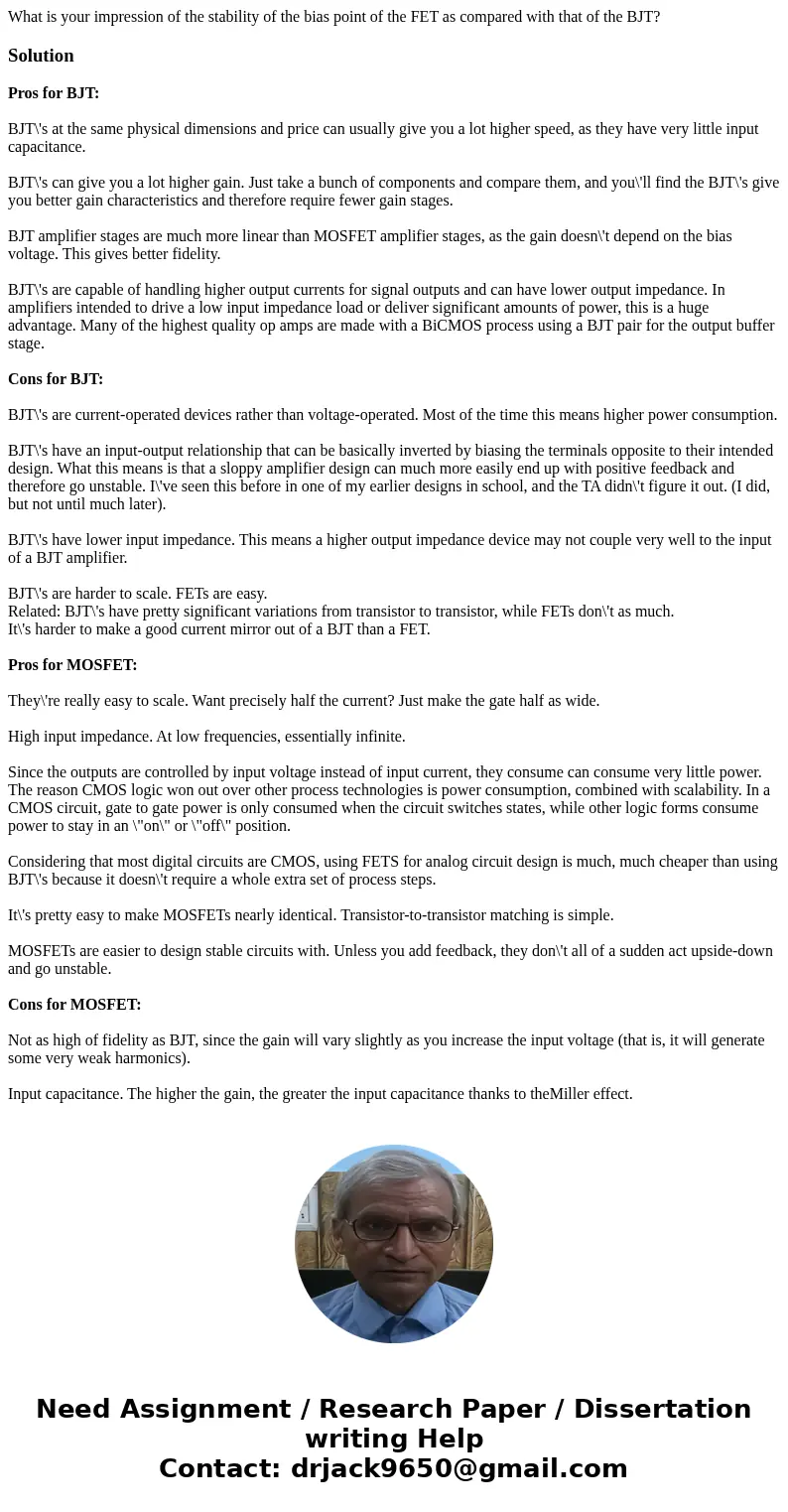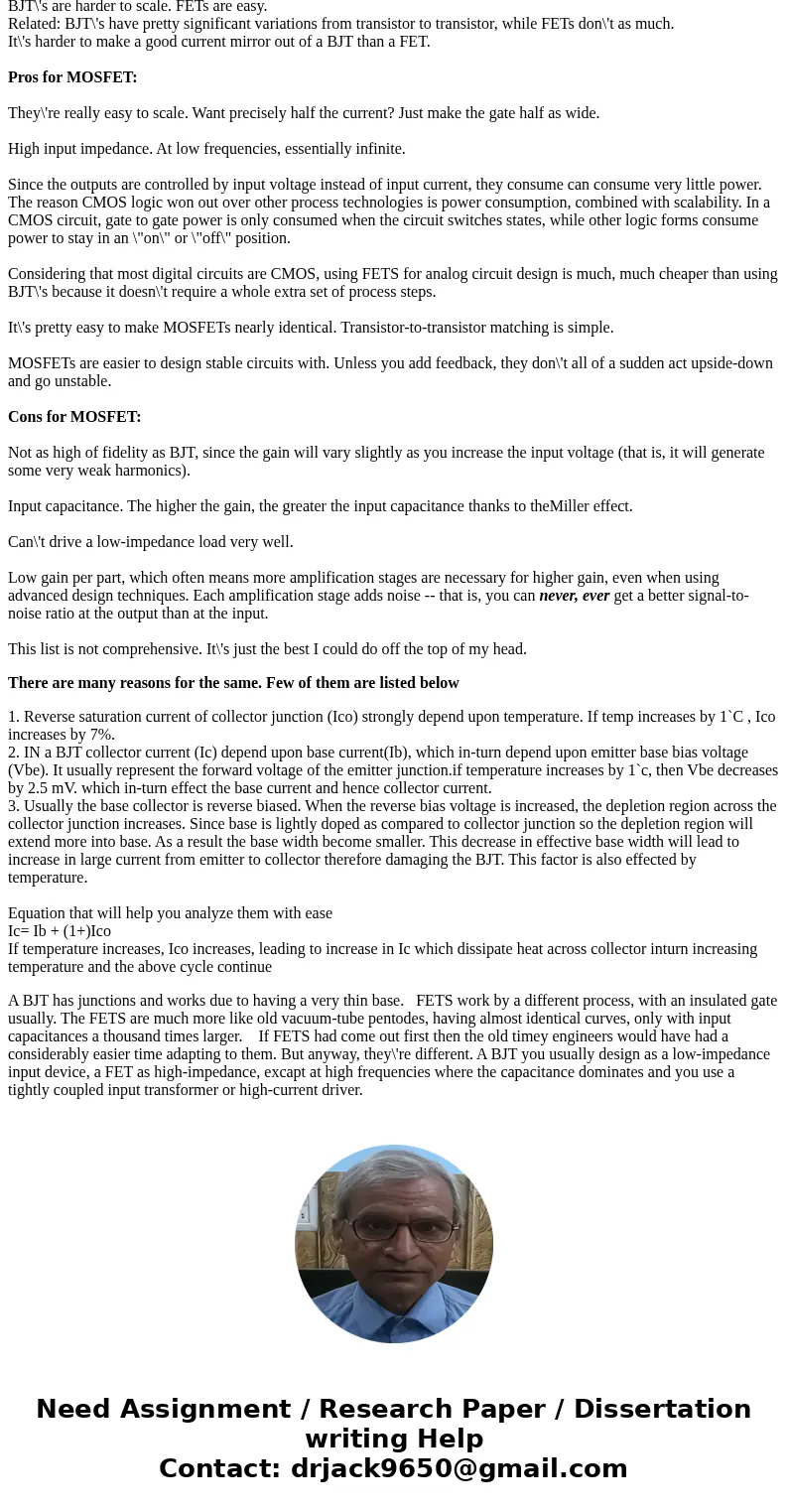What is your impression of the stability of the bias point o
What is your impression of the stability of the bias point of the FET as compared with that of the BJT?
Solution
Pros for BJT:
BJT\'s at the same physical dimensions and price can usually give you a lot higher speed, as they have very little input capacitance.
BJT\'s can give you a lot higher gain. Just take a bunch of components and compare them, and you\'ll find the BJT\'s give you better gain characteristics and therefore require fewer gain stages.
BJT amplifier stages are much more linear than MOSFET amplifier stages, as the gain doesn\'t depend on the bias voltage. This gives better fidelity.
BJT\'s are capable of handling higher output currents for signal outputs and can have lower output impedance. In amplifiers intended to drive a low input impedance load or deliver significant amounts of power, this is a huge advantage. Many of the highest quality op amps are made with a BiCMOS process using a BJT pair for the output buffer stage.
Cons for BJT:
BJT\'s are current-operated devices rather than voltage-operated. Most of the time this means higher power consumption.
BJT\'s have an input-output relationship that can be basically inverted by biasing the terminals opposite to their intended design. What this means is that a sloppy amplifier design can much more easily end up with positive feedback and therefore go unstable. I\'ve seen this before in one of my earlier designs in school, and the TA didn\'t figure it out. (I did, but not until much later).
BJT\'s have lower input impedance. This means a higher output impedance device may not couple very well to the input of a BJT amplifier.
BJT\'s are harder to scale. FETs are easy.
Related: BJT\'s have pretty significant variations from transistor to transistor, while FETs don\'t as much.
It\'s harder to make a good current mirror out of a BJT than a FET.
Pros for MOSFET:
They\'re really easy to scale. Want precisely half the current? Just make the gate half as wide.
High input impedance. At low frequencies, essentially infinite.
Since the outputs are controlled by input voltage instead of input current, they consume can consume very little power. The reason CMOS logic won out over other process technologies is power consumption, combined with scalability. In a CMOS circuit, gate to gate power is only consumed when the circuit switches states, while other logic forms consume power to stay in an \"on\" or \"off\" position.
Considering that most digital circuits are CMOS, using FETS for analog circuit design is much, much cheaper than using BJT\'s because it doesn\'t require a whole extra set of process steps.
It\'s pretty easy to make MOSFETs nearly identical. Transistor-to-transistor matching is simple.
MOSFETs are easier to design stable circuits with. Unless you add feedback, they don\'t all of a sudden act upside-down and go unstable.
Cons for MOSFET:
Not as high of fidelity as BJT, since the gain will vary slightly as you increase the input voltage (that is, it will generate some very weak harmonics).
Input capacitance. The higher the gain, the greater the input capacitance thanks to theMiller effect.
Can\'t drive a low-impedance load very well.
Low gain per part, which often means more amplification stages are necessary for higher gain, even when using advanced design techniques. Each amplification stage adds noise -- that is, you can never, ever get a better signal-to-noise ratio at the output than at the input.
This list is not comprehensive. It\'s just the best I could do off the top of my head.
There are many reasons for the same. Few of them are listed below
1. Reverse saturation current of collector junction (Ico) strongly depend upon temperature. If temp increases by 1`C , Ico increases by 7%.
2. IN a BJT collector current (Ic) depend upon base current(Ib), which in-turn depend upon emitter base bias voltage (Vbe). It usually represent the forward voltage of the emitter junction.if temperature increases by 1`c, then Vbe decreases by 2.5 mV. which in-turn effect the base current and hence collector current.
3. Usually the base collector is reverse biased. When the reverse bias voltage is increased, the depletion region across the collector junction increases. Since base is lightly doped as compared to collector junction so the depletion region will extend more into base. As a result the base width become smaller. This decrease in effective base width will lead to increase in large current from emitter to collector therefore damaging the BJT. This factor is also effected by temperature.
Equation that will help you analyze them with ease
Ic= Ib + (1+)Ico
If temperature increases, Ico increases, leading to increase in Ic which dissipate heat across collector inturn increasing temperature and the above cycle continue
A BJT has junctions and works due to having a very thin base. FETS work by a different process, with an insulated gate usually. The FETS are much more like old vacuum-tube pentodes, having almost identical curves, only with input capacitances a thousand times larger. If FETS had come out first then the old timey engineers would have had a considerably easier time adapting to them. But anyway, they\'re different. A BJT you usually design as a low-impedance input device, a FET as high-impedance, excapt at high frequencies where the capacitance dominates and you use a tightly coupled input transformer or high-current driver.


 Homework Sourse
Homework Sourse